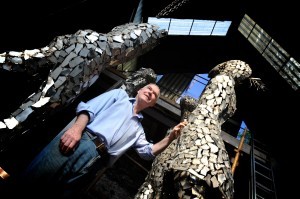 A CO Donegal artist has been commissioned to produce a sculpture of one of Co Derry’s most famous historical figures.
A CO Donegal artist has been commissioned to produce a sculpture of one of Co Derry’s most famous historical figures.
Burt man Maurice Harron will unveil his sculpture of Finvola O’Cathain in Dungiven later this month.
Folklore says Finvola, the young and beautiful daughter of Dermot, the chieftain of the O’Cathains, fell in love with Aengus McDonnell of the McDonnell Clan from the western isles of Scotland more than 700 years ago.
Dermot consented to the marriage on the condition that on his daughter’s death, she would be brought back to Dungiven for burial.
When she did die, Aengus would not return her body.
On Benbradagh Mountain, Finvola’s two brothers heard a piercing wail and recognising the call of the banshee, Grainne Rua, knew that a member of their clan had died.
The brothers set sail for Islay, where they recovered Finvola’s body and brought her home to Dungiven, setting the banshee’s cry to rest.
Artist Maurice, pictured above with a previous work, said: “Finvola, a princess of the O’Cathain clan, is famous for her great beauty.
“She united western Scotland and north-eastern Ireland through her marriage to Angus MacDonnell, Lord of the Isles.
“In the larger than life size sculpture, she will be seen dancing, whirling in a dynamic movement and is in the act of playing the harp.
“The design is informed by history and musical heritage. It is also a reference to the Bardic Harp School commemorated in the ‘Harper’s Walk’ path, close to the Priory.”
Mr Harron worked with six local schools and community groups to create a ceramic wall panel, which is now on display inside Dungiven library.
The collection extends across the main internal wall in the form of the flowing River Roe.
“We held a series of active workshops and the children each made a ceramic tile, inspired by their locality and heritage,” said Mr Harron.
Maurice’s works are on display all over the world – including his Hands Across the Divide work in Derry and Red Hugh in Roscommon.
Tags:







